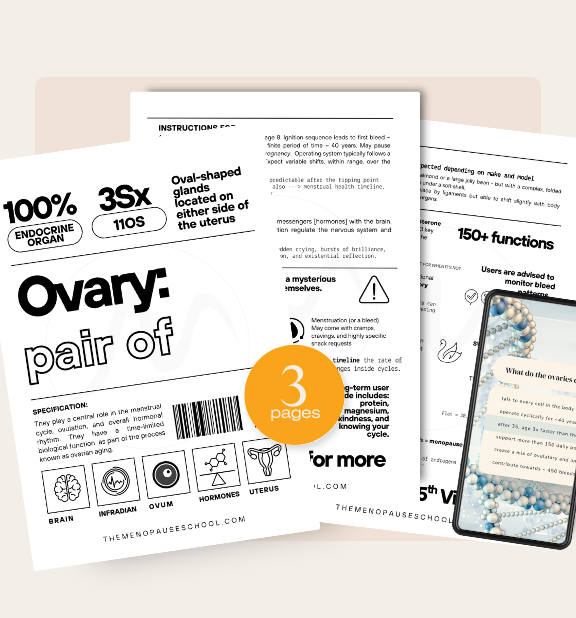The Myth of the Oestrogen ‘Drop’
Prefer to read it later? Download a copy of this article HERE (no email required)
And why are we only just finding out why it’s not true!
When people say there is a “drop in oestrogen” during perimenopause, they’re usually referring to changes in estradiol levels as the ovaries age. The phrase “drop” suggests a steady or gradual decline. In reality, this doesn’t match what the best longitudinal data shows.
Likewise, saying oestrogen is "low" in perimenopause, when it quite honestly is not, means many continue to live with challenging symptoms they believe are due to "low oestrogen", when it could be quite the opposite. Let’s break it down clearly:
📉 What does ‘drop’ actually mean?
In scientific terms, a “drop” would imply:
A consistent downward trend in oestrogen levels.
Possibly a sharp fall from a previous stable state → and the cause of symptoms
A measurable, progressive decline —> oestrogen deficiency
My pet peeve firstly is that narrators really should be specific and say estradiol and not oestrogen. Estradiol is the oestrogen made by ovaries in large amounts during menstrual cycles. Seeing as the focus of perimenopause is when cycles are changing (rightly or wrongly) then we should use menstrual cycle- specific terms = estradiol.
This ‘drop’ idea frames perimenopause as a hormone loss issue from the start, when in reality, the biology tells a different story. In fact estradiol doesn’t behave that way in perimenopause at all.
Instead, research from SWAN and other cohort studies shows that estradiol:
Often rises or becomes erratic before declining.
Has four trajectory patterns, not one universal drop.
So using “drop” or “low” is inaccurate unless referring specifically to the late stage of the transition (within ~12 months of final menstrual period), and even then it depends on the individual trajectory.
🧠 Who started this myth and why does it persist?
The “oestrogen drop” myth likely emerged from:
Postmenopausal hormone research (1990s–early 2000s):
Researchers and clinicians generalised postmenopausal hormone profiles backwards into perimenopause.
Early menopause awareness campaigns:
Used simplified messaging (e.g. “your hormones are crashing”) to drive public understanding and MHT uptake.
Lack of language for fluctuation:
It gave people a single narrative, even though estradiol behaves very differently depending on the person and phase.
📊 What does the data actually show?
The Study of Women's Health Across the Nation (SWAN) identified four estradiol patterns:
Rise–Early Decline (31.5%)
Rise–Late Decline (13.1%)
Flat (28.6%)
Low–Slow (26.9%)
Only one (Low–Slow) reflects a consistent downward trend from the start. The rest show initial rises, erratic peaks, or relatively stable patterns until close to menopause day. These patterns matter because symptoms often occur when levels are high or fluctuating, not low.
You may be thinking, ‘wow this new research is cool stuff, I can’t wait to share it with my friends and colleagues’. If you haven’t already clicked through to the SWAN research, prepare to be confused.
The information on the four trajectories was published in 2012. You can see it listed here on the SWAN website here on page 51, publication 416.
Read all 87 Citations here
The image above originates from here
This work is quoted in a follow-up study called ‘Characterizing the trajectories of vasomotor symptoms across the menopausal transition’ - you can read it here
And also referred to in this review -
Menopause Transition and Cardiovascular Disease Risk: Implications for Timing of Early Prevention: A Scientific Statement From the American Heart Association. Here
And you will read about it on page 35 of The Menopause Manifesto, by Dr Jen Gunter, or here on her blog
So why does the "low" oestrogen myth still persist?
I would really love to know why the information on the four estradiol trajectories is not mainstream news? Why is the popular narrative, that has been very vocal since 2019 (7 years after publication), has chosen to share a different story?
It seems to me that the very people, the larger than life menopause professionals aim to help, are in fact being let down by inaccurate information.
The idea of a neat “oestrogen drop” has stuck because it’s simple and easy to sell. But simple isn’t always true. Perimenopause is not a straight line down; it’s a shifting rhythm with multiple possible patterns. And progesterone loss - not just estradiol - is often what drives the early changes.
So when public voices keep telling people to “fix low oestrogen,” they miss the bigger picture. They turn a complex transition into a deficiency problem and, in doing so, close down the real conversation we need to have about hormone rhythms, nervous system sensitivity, and whole-body health.
It’s time to move past the myth. Perimenopause deserves better than a one-size-fits-all hormone story. The science has been here for over a decade. The question now is whether we’re finally ready to listen — and start talking about menopause the way it actually happens.
📥 The quick-read to keep on hand
The Ovary User Guide is a short, sharp, 3-minute read designed to:
Give a snapshot of the ovaries’ physical features, functions, and rhythms.
Present biology in a playful but precise style, with quick facts, cues, and memorable phrasing.
Surprise professionals who thought they already “knew” about the ovaries.
Hint at the bigger menstrual health timeline without unpacking it all.
Think field guide meets quick-reference card. Skim it once, and you’ll start spotting ovarian clues in your clients the very same day. Scroll down to grab a copy now!
If you are interested in learning more about The Menopause Doula Training course click HERE
If you join before the end of August there’s a 20% off coupon code: AUG20



